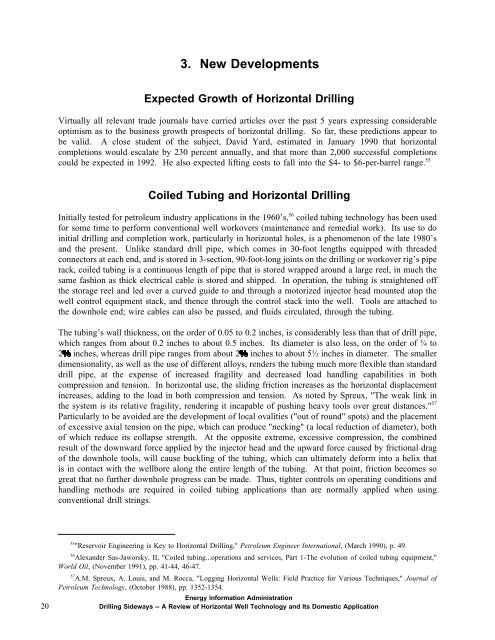Drilling Sideways -- A Review of Horizontal Well Technology ... - EIA
Drilling Sideways -- A Review of Horizontal Well Technology ... - EIA
Drilling Sideways -- A Review of Horizontal Well Technology ... - EIA
Create successful ePaper yourself
Turn your PDF publications into a flip-book with our unique Google optimized e-Paper software.
3. New Developments<br />
Expected Growth <strong>of</strong> <strong>Horizontal</strong> <strong>Drilling</strong><br />
Virtually all relevant trade journals have carried articles over the past 5 years expressing considerable<br />
optimism as to the business growth prospects <strong>of</strong> horizontal drilling. So far, these predictions appear to<br />
be valid. A close student <strong>of</strong> the subject, David Yard, estimated in January 1990 that horizontal<br />
completions would escalate by 230 percent annually, and that more than 2,000 successful completions<br />
could be expected in 1992. He also expected lifting costs to fall into the $4- to $6-per-barrel range. 55<br />
Coiled Tubing and <strong>Horizontal</strong> <strong>Drilling</strong><br />
Initially tested for petroleum industry applications in the 1960’s, 56 coiled tubing technology has been used<br />
for some time to perform conventional well workovers (maintenance and remedial work). Its use to do<br />
initial drilling and completion work, particularly in horizontal holes, is a phenomenon <strong>of</strong> the late 1980’s<br />
and the present. Unlike standard drill pipe, which comes in 30-foot lengths equipped with threaded<br />
connectors at each end, and is stored in 3-section, 90-foot-long joints on the drilling or workover rig’s pipe<br />
rack, coiled tubing is a continuous length <strong>of</strong> pipe that is stored wrapped around a large reel, in much the<br />
same fashion as thick electrical cable is stored and shipped. In operation, the tubing is straightened <strong>of</strong>f<br />
the storage reel and led over a curved guide to and through a motorized injector head mounted atop the<br />
well control equipment stack, and thence through the control stack into the well. Tools are attached to<br />
the downhole end; wire cables can also be passed, and fluids circulated, through the tubing.<br />
The tubing’s wall thickness, on the order <strong>of</strong> 0.05 to 0.2 inches, is considerably less than that <strong>of</strong> drill pipe,<br />
which ranges from about 0.2 inches to about 0.5 inches. Its diameter is also less, on the order <strong>of</strong> ¾ to<br />
2 inches, whereas drill pipe ranges from about 2 inches to about 5½ inches in diameter. The smaller<br />
dimensionality, as well as the use <strong>of</strong> different alloys, renders the tubing much more flexible than standard<br />
drill pipe, at the expense <strong>of</strong> increased fragility and decreased load handling capabilities in both<br />
compression and tension. In horizontal use, the sliding friction increases as the horizontal displacement<br />
increases, adding to the load in both compression and tension. As noted by Spreux, "The weak link in<br />
the system is its relative fragility, rendering it incapable <strong>of</strong> pushing heavy tools over great distances." 57<br />
Particularly to be avoided are the development <strong>of</strong> local ovalities ("out <strong>of</strong> round" spots) and the placement<br />
<strong>of</strong> excessive axial tension on the pipe, which can produce "necking" (a local reduction <strong>of</strong> diameter), both<br />
<strong>of</strong> which reduce its collapse strength. At the opposite extreme, excessive compression, the combined<br />
result <strong>of</strong> the downward force applied by the injector head and the upward force caused by frictional drag<br />
<strong>of</strong> the downhole tools, will cause buckling <strong>of</strong> the tubing, which can ultimately deform into a helix that<br />
is in contact with the wellbore along the entire length <strong>of</strong> the tubing. At that point, friction becomes so<br />
great that no further downhole progress can be made. Thus, tighter controls on operating conditions and<br />
handling methods are required in coiled tubing applications than are normally applied when using<br />
conventional drill strings.<br />
55 "Reservoir Engineering is Key to <strong>Horizontal</strong> <strong>Drilling</strong>," Petroleum Engineer International, (March 1990), p. 49.<br />
56<br />
Alexander Sas-Jaworsky, II, "Coiled tubing...operations and services, Part 1-The evolution <strong>of</strong> coiled tubing equipment,"<br />
World Oil, (November 1991), pp. 41-44, 46-47.<br />
57<br />
A.M. Spreux, A. Louis, and M. Rocca, "Logging <strong>Horizontal</strong> <strong>Well</strong>s: Field Practice for Various Techniques," Journal <strong>of</strong><br />
Petroleum <strong>Technology</strong>, (October 1988), pp. 1352-1354.<br />
Energy Information Administration<br />
20 <strong>Drilling</strong> <strong>Sideways</strong> -- A <strong>Review</strong> <strong>of</strong> <strong>Horizontal</strong> <strong>Well</strong> <strong>Technology</strong> and Its Domestic Application

















